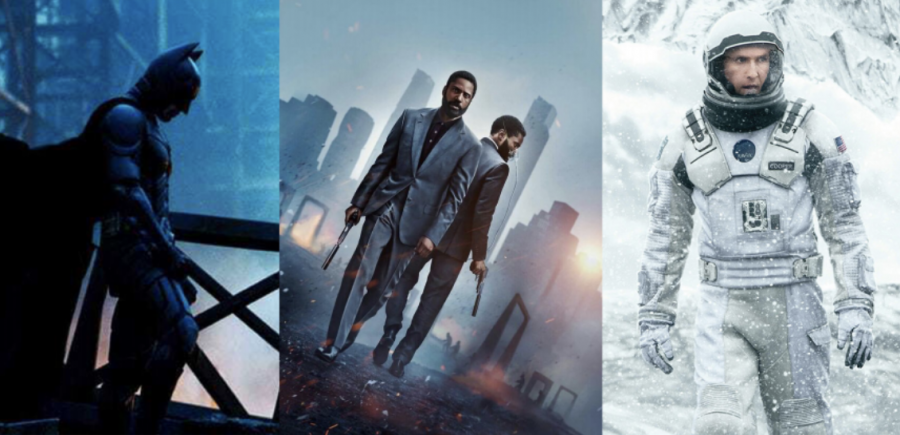Christopher Nolan: Behind the set
cinema.com, inverse.com, theatlantic.com
INTRODUCING (from left to right): Batman from Christopher Nolan’s “The Dark Knight,” the Protagonist from his latest film “Tenet” and Joseph Cooper from “Interstellar.”
September 27, 2020
Christopher Nolan: filmmaker, director, scriptwriter and legend cemented into cinema history. Whether it’s “Interstellar,” a science-fiction film that stretches the boundaries of your imagination or “The Dark Knight,” a masterpiece superhero movie featuring an iconic representation of the Joker, his name alone evokes the most critically acclaimed movies of this generation. His newest movie “Tenet,” released in theaters Sept. 3rd, provides fans with yet another opportunity to appreciate Nolan’s distinctive cinematic style, a style he has perfected over the last two decades.
Nolan’s initial directorial work, “Following,” was neither well-known nor well-funded, but established a non-linear narrative scheme that became the hallmark of his second film, “Memento.” Released in 2001, “Memento” earned Nolan the first of many Academy Award nominations and gave mainstream audiences their first glimpse of Nolan’s talent.
But not everything is accomplished by pure talent. Nolan puts immense effort into pre-production research, matching his vision to reality as accurately as possible. Prior to filming “Interstellar,” for example, Nolan consulted with established scientists to understand wormholes and time. This effort results in a believable universe that ultimately gives viewers a reason to consistently rewatch his films, a feat that few directors achieve.
For Nolan, innovation and testing the limits of practical effects over computer graphics enhance the believable universe for the audience. Authenticity is key, no matter the time or money required to shoot each sequence. Scenes like the truck flipping over and exploding in “The Dark Knight” and the zero-gravity inducing rotating room in “Inception” are memorable moments in both movies because of his care for crafting a genuine world.
This combines with his stellar camerawork, outstanding musical scores and descriptive screenwriting to produce Nolan’s masterpieces. In a world where formulaic, bland action movies have oversaturated Hollywood, his complex films are a relief for moviegoers who appreciate an experience rather than a distraction.
To no one’s surprise, when “Tenet” was announced earlier this year, that the hype train took off—and fast. Each of the three trailers reached at least 10 million views on YouTube, and despite several delays due to COVID-19, interest has remained high. Still, with many people reluctant to visit movie theaters, the future of “Tenet” remains unclear.
When you finally have the opportunity to watch “Tenet” or any of Nolan’s other masterpieces, keep an eye out for Nolan’s key trademarks. And if you don’t catch them the first time, watch it again, and again. Just like his movie-making process, it takes time, and effort, to grasp the genius behind his work.



![AAAAAND ANOTHER THING: [CENSORED] [REDACTED] [BABY SCREAMING] [SIRENS] [SILENCE].](https://thehowleronline.org/wp-content/uploads/2025/06/lucy-1200x800.jpg)





















































